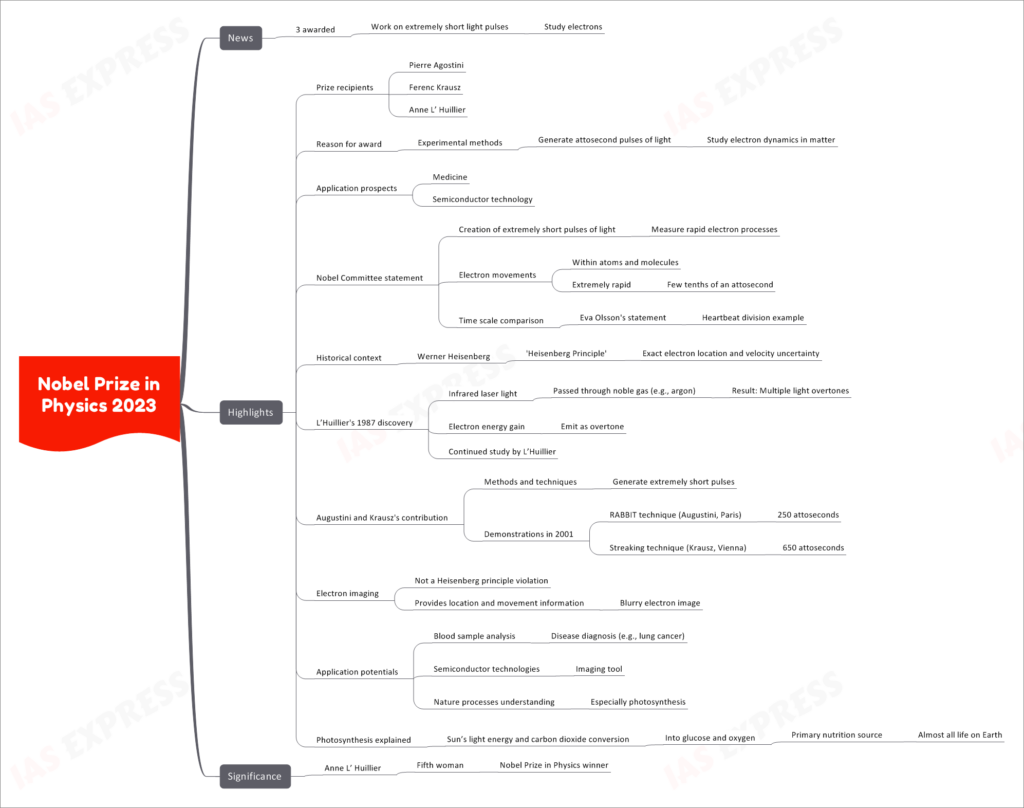Nobel Prize in Physics 2023

In a remarkable recognition of scientific achievement, the Nobel Prize in Physics 2023 has been awarded to three distinguished scientists for their groundbreaking work on extremely short light pulses, which has opened new frontiers in understanding the dynamics of electrons in matter.
Highlights
Prize Recipients
The Nobel Prize in Physics 2023 has been awarded to:
- Pierre Agostini
- Ferenc Krausz
- Anne L’Huillier
Reason for Award
The Nobel Committee acknowledged their pioneering work in experimental methods to generate attosecond pulses of light, enabling the study of electron dynamics in matter with unprecedented precision.
Application Prospects
The applications of their research span across various fields, including:
- Medicine: Advancements in understanding electron dynamics can have applications in medical diagnostics.
- Semiconductor Technology: These insights can lead to improved imaging tools for semiconductor technologies.
Nobel Committee Statement
The Nobel Committee stated that the laureates’ creation of extremely short pulses of light has allowed scientists to measure rapid electron processes, revealing the movements of electrons within atoms and molecules with time scales as short as a few tenths of an attosecond.
Historical Context
Their work builds upon the foundation laid by Werner Heisenberg and his famous ‘Heisenberg Principle,’ which introduced the concept of the inherent uncertainty in knowing both the exact location and velocity of an electron.
Anne L’Huillier’s 1987 Discovery
Anne L’Huillier’s pivotal contribution dates back to 1987 when she discovered that by passing infrared laser light through noble gases like argon, multiple light overtones were generated. This phenomenon resulted in electron energy gain and emission as overtones. Her continued research paved the way for the breakthroughs that followed.
Augustini and Krausz’s Contribution
Pierre Agostini and Ferenc Krausz developed methods and techniques to generate extremely short pulses of light, achieving demonstrations in 2001. Agostini in Paris utilized the RABBIT technique to reach 250 attoseconds, while Krausz in Vienna employed the streaking technique to achieve 650 attoseconds.
Electron Imaging: Not a Heisenberg Principle Violation
Their research on electron imaging, despite the Heisenberg Principle, provides valuable information about the location and movement of electrons, even though the images may appear blurry.
Application Potentials
The practical applications of this research are far-reaching:
- Blood Sample Analysis: It can revolutionize disease diagnosis, including conditions like lung cancer.
- Semiconductor Technologies: The technology can serve as a powerful imaging tool.
- Understanding Nature Processes: It can deepen our understanding of complex natural processes, particularly photosynthesis.
Explaining Photosynthesis
Their work sheds light on the intricate process of photosynthesis, where the sun’s light energy is converted into glucose and oxygen, serving as the primary nutrition source for nearly all life on Earth.
Significance
The Nobel Prize in Physics 2023 not only celebrates the remarkable contributions of Pierre Agostini, Ferenc Krausz, and Anne L’Huillier to the field of physics but also highlights the increasing recognition of women’s excellence in the scientific community, with Anne L’Huillier being the fifth woman to receive this coveted award in physics.
If you like this post, please share your feedback in the comments section below so that we will upload more posts like this.

